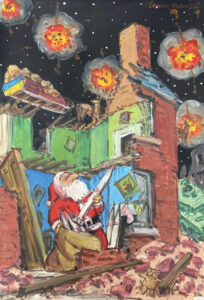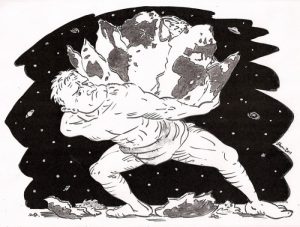Satire, August 2024
- Posted by Lawrence Mathias
- On
Where do you start with satire and parody? In the media world of today’s incessant news coverage and ‘info-tainment’, where do we, the recipients, get off the bus and take a breather? As a kind of enforced white noise backdrop to life, a deep cynicism can sometimes creep into our worldviews: narcissistic politicians; double dealings on the world stage; political expediency and unbridled acts of cruelty. What the hell is going on? And a climate disaster waiting in the wings, impending natural disaster to compound the political inadequacies put on show for our contemplation.
But it ain’t all cut and dried cock-up and misfortune. Everything is simplified for news magazine purposes, and worse still, the deeper flows of dark money and political manipulation is often at play to skew our first impressions of immensely complex social and historical issues.
I think this is where satire does its bit. Any decent bit of cartoonery shouldn’t take itself too seriously, it defies the object of its purpose if it does, and when it makes a stab at a humorous appraisal of a situation like a political crisis or piece of human folly it can offer a perspective that is different or just a little wider than the one which might be commonly served up.
For example, the ‘Migration Crisis’, one of those sparks that contributed to the house fire that was Brexit, can be turned around and viewed from the perspective of those seeking refuge. ‘Big Ships, Little Ships’ above is a viewpoint more from those imperilling their lives in small boats to reach the safety of the West. Instead of sympathy for the plight of those tossed upon the waves, a wall, in this case, a blockade of ships, is placed across their paths.
And then there’s the immensity of the horror of a situation like Gaza. Where does such horror begin and end? When we scratch the surface beyond the news desks we find a situation mired in late 19th century ideals, persecution and disillusionment and brutal colonialism with nuances on all sides. Successful satire can, for a moment, cut through all the complexity and offer a memorable summing up. That is, if it works…
The beauty of satire is its brevity and simplicity, but also its ability to somehow catch an aspect of a situation. And aside from these qualities, it has an aesthetic standard similar but different to more rarefied artistic standards. The satire I like to practice is one of line, form and colour, and the better pieces I think I’ve managed to knock up have gone a little way down the path to realising these standards.
 Santa always gets his deliveries through
Santa always gets his deliveries through
So for me, both as a moment’s tonic for the dystopic offerings around us and as a way to engage creatively, satire is a necessary and fascinating art form. There’s a lot of great artists who have practiced it as well, artists as varied as Hogarth and Hockney, to name a couple of British ones, so anyone who tries their hand at it is in good company.




